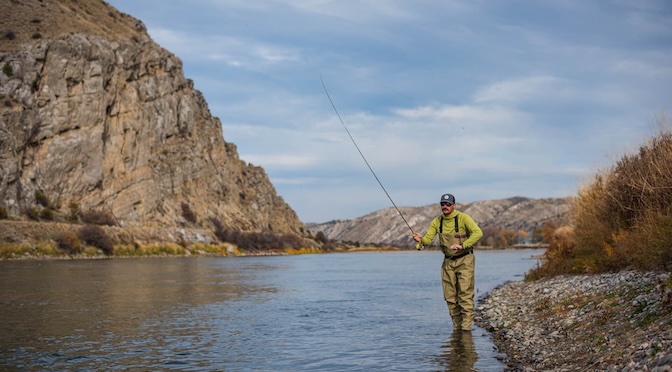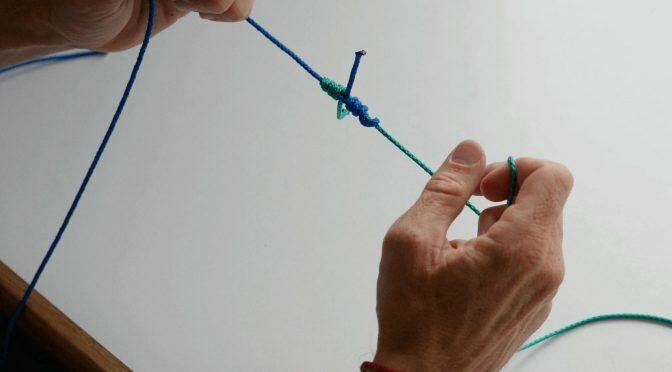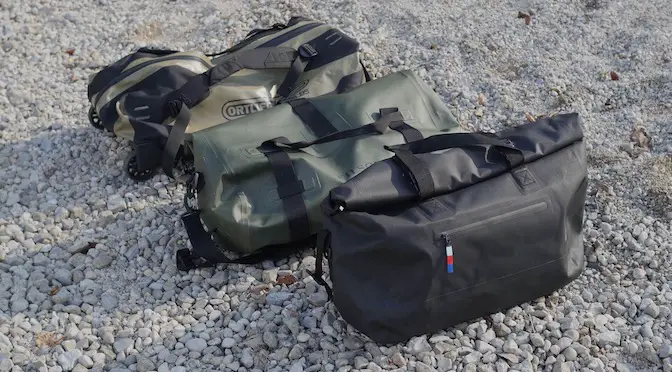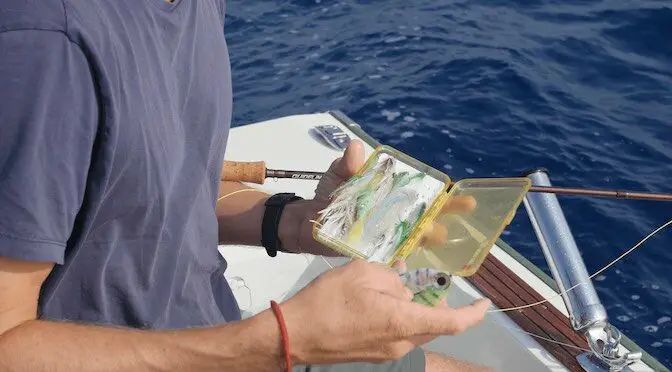Last updated on November 10th, 2025.
- Can YETI’s new backpack deliver? Thoughts on the YETI CAYO - November 20, 2025
- How to Put a Worm on a Hook: Proven Methods for a Perfect Bait - November 18, 2025
- How to Fish in a River: An Essential Guide to Proven Techniques - November 18, 2025
Your First Cast: The Leader & Tippet Cheat Sheet
A leader is the tapered, transparent line connecting your thick fly line to your fly, while the tippet is the thinnest, final section of that leader that you tie your fly to. The leader is the crucial link that connects your thick, colored fly line to your fly, and its main job is to transfer casting energy smoothly for a delicate presentation. The tippet is the thinnest, final section of the leader and is the part you tie directly to your fly. The term “tippet” can also refer to the material on a small spool used to replace or extend this section. While choosing the right gear can feel overwhelming, especially when compared to the relative simplicity of selecting from the different types of fishing reels in the spin fishing world, the leader and tippet system is easy to master once you understand the basics. The most important takeaway is that you must match your tippet’s diameter (its “X” size) to the size of your fly, as this single skill is the key to making your fly drift naturally on the water.
The Anatomy of Your Fly Fishing Connection
A leader is the entire tapered connection from your fly line to your fly, while the tippet is both the name for the leader’s final section and the material used to repair it. The fundamental purpose of a leader is to connect the fly line to the fly in a way that allows you to catch fish. It’s the invisible bridge between your powerful cast and a subtle presentation that won’t spook the fish. The word “tippet” has a dual meaning, which is a common source of confusion. It is both the name for the final, level-diameter section of a pre-made leader and the name for the material, sold on small two-inch spools, used to repair and customize that section. For a fly angler, the terminal tackle is more complex than for a spin fisherman. You’re not just tying a lure to a line; you’re managing a tapered system designed for finesse. Being able to see these fine lines and the fish’s reaction is critical, which is why many anglers rely on the best polarized sunglasses for fishing. Over time, you may encounter different types of leaders, including tapered vs. level, single-piece vs. knotted, and those made from materials like solid, braided, or furled monofilament.
Why Your Tippet is the Most Important Link in the Chain
Your tippet is the most critical link because it directly controls the fly’s presentation in the water and serves as the system’s designated breaking point. The tippet is the only piece of your equipment that directly dictates how the fly behaves on or in the water. A proper, natural-looking drift is impossible without the correct tippet for the conditions. Furthermore, the tippet, being the thinnest part of the system, ultimately defines the leader’s breaking strength. It’s the purposefully weakest link that protects the rest of your setup from breaking off on a snag or a strong fish. The consequences of a mismatch are significant. A tippet that is too stiff for the fly will drag it unnaturally through the water, while one that is too flimsy will fail to deliver the fly accurately, often collapsing in a heap.
Decoding Tippet Sizes: The “X” System Explained
Tippet is sized by its diameter using an “X” rating, where a higher X number means a thinner line. Unlike conventional fishing line, tippet is primarily categorized by its diameter, represented by an “X” size (e.g., 3X, 4X, 5X). The system is inverse: the higher the “X” number, the thinner the diameter of the material. For a concrete reference, a manufacturer’s 5X material should be .006” in diameter, while a 3X material should be .008” in diameter. It’s crucial to understand a common misconception: X size corresponds to diameter, not necessarily breaking strength. A 4X tippet from one brand may have a different pound-test rating than a 4X from another, even if their diameters are the same. This is a key difference from how anglers think about when to use braided fishing line, which is almost always categorized by its pound test.
Nylon vs. Fluorocarbon: Choosing the Right Material
Choose nylon tippet for floating dry flies and nearly invisible fluorocarbon tippet for fishing nymphs and streamers beneath the surface. Nylon is the go-to material for dry flies. Its primary benefit is that it floats, which is essential for keeping a dry fly riding high on the surface. It is also generally more forgiving with knots and has more stretch than its counterpart. Fluorocarbon is the ideal choice for subsurface fishing with nymphs, streamers, and wet flies. Its main advantages are its near-invisibility in water and superior abrasion resistance, which makes it particularly effective for leader-shy fish or in rocky environments. It’s important to practice environmental responsibility: fluorocarbon does not biodegrade, and all scraps must be packed out. In some specialized situations, anglers use a “bite” tippet—a special, extra-tough section of thick monofilament or wire used for toothy fish like pike or tarpon.
The A.M.S. Tippet Selection System
To choose the right tippet, simply Assess the conditions, Match the tippet size to the fly size using the “Rule of 3,” and Select the material based on your fly type. This simple three-step process removes the guesswork.
STEP 1: ASSESS the Conditions & Target First, evaluate the fishing scenario. For big fish, big flies, or fast water, you’ll need a heavier, stronger tippet, typically in the 3X to 4X range. For smaller flies, spooky fish, or calm, clear water, a lighter, thinner tippet like 5X or 6X is a better choice.
STEP 2: MATCH the Tippet to the Fly Use the “Rule of 3” (or “Rule of 4”). To find the right tippet X size, simply divide the fly’s size number by 3 or 4. For example, a size 12 fly would require a 3X or 4X tippet (12 / 3 = 4, or 12 / 4 = 3). This ensures the tippet is stiff enough to turn the fly over but flexible enough to allow a natural drift.
STEP 3: SELECT the Material Finally, choose your material based on the fly type. If you’re fishing a dry fly on the surface, select Nylon. If you’re fishing a nymph or streamer subsurface, select Fluorocarbon. This simple decision is just one part of getting ready for a day on the water, along with deciding what to wear under waders and packing your gear.
Common Leader & Tippet Pitfalls to Avoid
The most common tippet mistakes are choosing a size that is too thick or too thin for your fly, which ruins your drift or causes tangles. By understanding these pitfalls, you can avoid a lot of frustration on the water.
MISTAKE 1: Going Too Thick. Using a tippet that is too thick and stiff for the fly size will kill its natural movement in the water. This creates unnatural drag, resulting in an unappealing drift that fish will almost always ignore.
MISTAKE 2: Going Too Thin. Using a tippet that is too thin for the fly size will fail to transfer casting energy properly from the leader. This prevents the leader from turning over and extending correctly, often resulting in a tangled, “piled” mess instead of a delicate presentation.
MISTAKE 3: Mixing Incompatible Brands. While not a disaster, different brands of tippet material can have slightly different stiffness and knotting properties. For the most consistent and reliable results, it’s often best to stick with one brand for both your leader and your tippet spools.
MISTAKE 4: Overcomplicating Things. While anglers historically built their own leaders from scratch using complex formulas, this is no longer necessary. Modern, off-the-shelf tapered leaders work exceptionally well and are all a beginner needs to get started and catch fish.
From Confused Angler to Confident Caster
With this knowledge, you can confidently select the right leaders and tippet to build a versatile and effective fly fishing setup. You can now walk into a fly shop, understand the difference between a leader and a tippet, and confidently select the right material and size for your needs. For a versatile trout setup, a great starting point is to carry a couple of standard leaders (e.g., a 9-foot 4X and a 7.5-foot 3X) and spools of tippet ranging from 3X to 6X. Many experienced trout anglers will have 4-5 spools on hand to cover any situation. To get started, look for some of the most reliable and recommended tippet brands, such as TroutHunter, Umpqua, Orvis, and Climax.
Bonus: The Other Kind of Tippet (And Why It Won’t Catch You a Fish)
The word “tippet” also refers to a black scarf worn by clergy in a church setting, a piece of trivia that has nothing to do with fishing. To avoid any future confusion, it’s worth knowing that in a church context, a tippet is a large black scarf worn by clergy over a surplice and cassock, typically during the Daily Offices. It resembles a stole and is worn around the neck with the ends hanging down, sometimes ornamented with emblems like a seminary’s insignia. So, while it shares a name, it definitely won’t help you present a dry fly.
Frequently Asked Questions
What is the difference between a leader and a tippet in fly fishing?
A leader is the entire tapered line connecting your thick fly line to your fly. The tippet is the thinnest, final section of the leader that you tie the fly to. ‘Tippet’ also refers to the material on a spool used to replace this section as it gets shorter.
How does the ‘X’ system for tippet sizes work?
The ‘X’ system measures a tippet’s diameter, not its breaking strength. The system is inverse, so a higher X number (like 6X) means a thinner line, while a lower X number (like 3X) means a thicker line.
How do I choose the right tippet size for my fly?
Use the ‘Rule of 3.’ Simply divide the fly’s size number by 3 or 4 to find the correct tippet X size. For example, a size 12 fly works well with a 3X or 4X tippet (12 / 3 = 4).
Should I use nylon or fluorocarbon tippet?
Use nylon for dry flies, as it floats and helps keep your fly on the surface. Use fluorocarbon for nymphs and streamers, as it’s nearly invisible underwater and more abrasion-resistant, making it ideal for subsurface fishing.
What is a good all-around leader and tippet setup for a beginner?
A versatile starting point for trout fishing is a 9-foot 4X or 5X tapered leader. You should also carry spools of tippet material in sizes 3X, 4X, 5X, and 6X to cover most situations and rebuild your leader as needed.
What kind of leader should I use with a sinking fly line?
When fishing with a sinking line for streamers or wet flies, a short, stout leader is best. A simple 4 to 6-foot section of level 0X to 2X tippet material is often all you need to connect your sinking line to the fly.
Is tippet material tapered like a leader?
No, tippet material sold on spools is a level, non-tapered line of a consistent diameter. It is used to replace the final, level section of a pre-made tapered leader, which is also called the tippet.
What is a ‘bite tippet’ used for?
A ‘bite tippet’ is a special, extra-tough section of thick monofilament or wire tied between the leader and the fly. It is used when targeting toothy fish like pike, musky, or tarpon to prevent them from cutting through a standard tippet.
What is a tippet in church?
In a church context, a tippet is a large black scarf worn by clergy over their robes, typically during the Daily Offices. It has no connection to fishing and is often ornamented with emblems from the wearer’s seminary or church.






